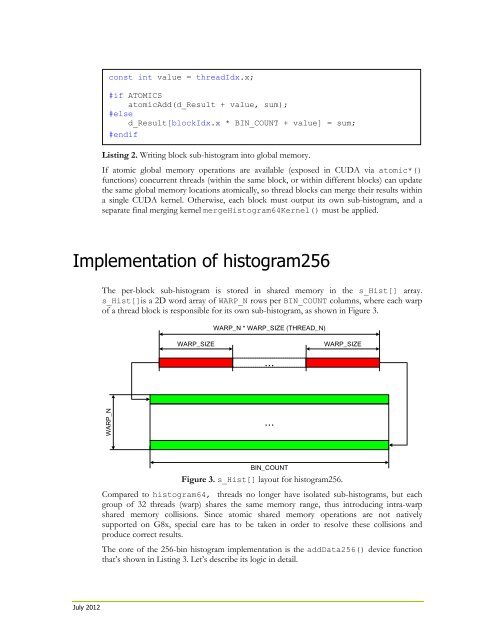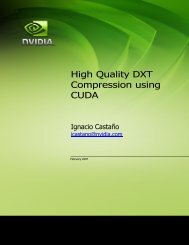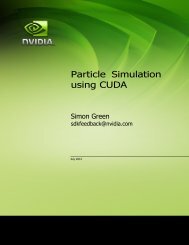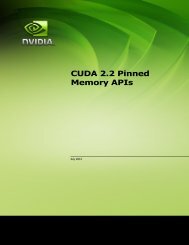Histogram calculation in CUDA
Whitepaper - nVIDIA CUDA Toolkit Documentation
Whitepaper - nVIDIA CUDA Toolkit Documentation
- No tags were found...
Create successful ePaper yourself
Turn your PDF publications into a flip-book with our unique Google optimized e-Paper software.
const <strong>in</strong>t value = threadIdx.x;<br />
#if ATOMICS<br />
atomicAdd(d_Result + value, sum);<br />
#else<br />
d_Result[blockIdx.x * BIN_COUNT + value] = sum;<br />
#endif<br />
List<strong>in</strong>g 2. Writ<strong>in</strong>g block sub-histogram <strong>in</strong>to global memory.<br />
If atomic global memory operations are available (exposed <strong>in</strong> <strong>CUDA</strong> via atomic*()<br />
functions) concurrent threads (with<strong>in</strong> the same block, or with<strong>in</strong> different blocks) can update<br />
the same global memory locations atomically, so thread blocks can merge their results with<strong>in</strong><br />
a s<strong>in</strong>gle <strong>CUDA</strong> kernel. Otherwise, each block must output its own sub-histogram, and a<br />
separate f<strong>in</strong>al merg<strong>in</strong>g kernel merge<strong>Histogram</strong>64Kernel() must be applied.<br />
Implementation of histogram256<br />
The per-block sub-histogram is stored <strong>in</strong> shared memory <strong>in</strong> the s_Hist[] array.<br />
s_Hist[]is a 2D word array of WARP_N rows per BIN_COUNT columns, where each warp<br />
of a thread block is responsible for its own sub-histogram, as shown <strong>in</strong> Figure 3.<br />
WARP_N * WARP_SIZE (THREAD_N)<br />
WARP_SIZE<br />
...<br />
WARP_SIZE<br />
WARP_N<br />
...<br />
BIN_COUNT<br />
Figure 3. s_Hist[] layout for histogram256.<br />
Compared to histogram64, threads no longer have isolated sub-histograms, but each<br />
group of 32 threads (warp) shares the same memory range, thus <strong>in</strong>troduc<strong>in</strong>g <strong>in</strong>tra-warp<br />
shared memory collisions. S<strong>in</strong>ce atomic shared memory operations are not natively<br />
supported on G8x, special care has to be taken <strong>in</strong> order to resolve these collisions and<br />
produce correct results.<br />
The core of the 256-b<strong>in</strong> histogram implementation is the addData256() device function<br />
that’s shown <strong>in</strong> List<strong>in</strong>g 3. Let’s describe its logic <strong>in</strong> detail.<br />
July 2012











